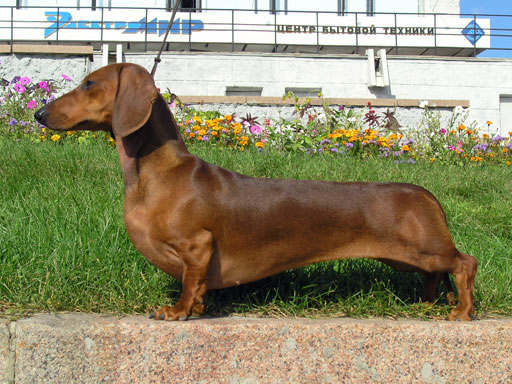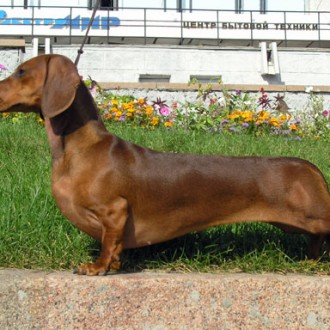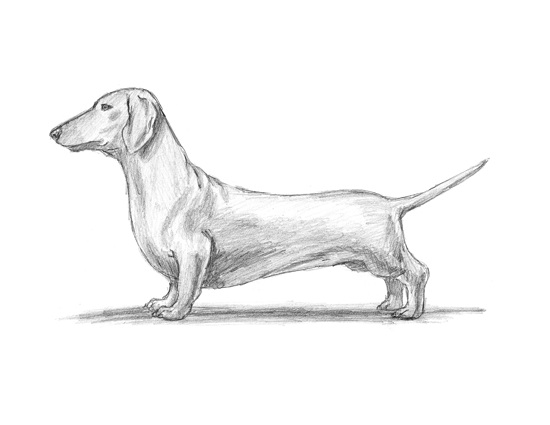


How to Draw a Dog (Dachshund)
Please PAUSE the video after each step to draw at your own pace (scroll down to see the final dachshund drawing).
For the first few steps, don’t press down too hard with your pencil. Use light, smooth strokes to begin.
Step 1: Draw two circles as guides for the dachshund’s body. They don’t have to be perfect. They’re just guides. The circle on the left should be smaller. Also pay close attention to the spacing of the circles. The farther apart the circles are, the longer your dog will be.
Step 2: Draw another circle on the top left side as a guide for the dachshund’s head. The circle should be slightly smaller and floating just above the dog’s body.
Step 3: Draw a vertical line that splits the dog’s head in half as a guide for the ear. And draw an arc on the left side of the head as a guide for the dachshund’s muzzle.
Step 4: Draw a series of curved lines that connect the major shapes to form the dachshund’s body. Draw a straight line on the right side for the dachshund dog’s tail.
Step 5: Draw two lines under the dachshund’s body (one below each circle) as guides for the dog’s legs.
That’s it for the initial sketch! From this point on, press harder with your pencil to get a more defined sketch.
Step 6: Draw the dachshund’s eye inside the head on the upper left side where the dog’s muzzle line begins. The shape of the eye is similar to a “greater than” sign (>). Draw a circle inside the sign for the dog’s eyeball. Shade in the eye except for a small circle to represent glare.
Step 7: Use the vertical line and the side of the circle as guides to draw the dachshund’s ear. Draw more curved lines to make the dog ear floppier. Also draw some lines within the shape to represent the folds and bends of the dog’s ear.
Step 8: Draw the dachshund’s nose on the left side at the tip of the arc. The shape of the dachshund nose is smaller to an upside-down triangle with rounded corners and a slit inside for the nostril.
Step 9: Use the arc as a guide to draw the rest of the dachshund dog’s muzzle. Draw a line below the nose that extends toward the main circle for the mouth. Then draw another similar line below that for the dog’s lower jaw.
Step 10: Use the main circle as a guide to draw the rest of the dachshund’s head.
Step 11: Using the line as a guide, draw the dachshund’s front legs. Draw lightly at first. When you like what you have, go ahead and darken it. Make the dog’s leg thicker on top and draw some bumps along the way to represent the dog’s joints. Draw a few lines at the bottom for the toes and small shapes at the end of the toes for the dog’s nails. Draw only the visible portion of the other leg the same way.
Step 12: Draw the dachshund’s hind legs using the same techniques as the front legs. Draw lightly at first to get the structure right, then darken it. Don’t forget the bumps for the dog’s joints and the toes! Now draw the other similar-looking leg peeking from the other side.
Step 13: Use the connecting lines as guides to draw the rest of the dachshund’s body. Draw a few curved lines along the neck to represent folds of skin. Using straight lines for the body creates a smooth-haired dachshund. For a long-haired coat, use quick, short strokes along the dog’s body.
Step 14: Draw the dachshund’s tail using the initial line as a guide.
Step 15 (optional): You can stop here for a sketchy look or erase as much as you can of the initial guide lines for a cleaner look. Don’t worry about erasing all of the guides. It’s okay to leave some behind. Also re-draw any final sketch lines that you may have accidentally erased.
Step 16 (optional): Add some shading to your dachshund dog drawing to give it more dimension and volume. Pick the direction of the light source when shading so that the shadows are consistent with it. Vary the pressure on your pencil to get different degrees of tonal value. Add a cast shadow underneath the dachshund dog. This helps ground the dog so it doesn’t appear to be floating.
Step 17 (optional): You can add more value throughout your drawing for extra detail. It’s a good idea to use reference to be as accurate as possible. Remember to PAUSE the video any time you need help along the way.



